Stories about weapons. Combat "Sexton:" self-propelled guns "Sexton Mk-I (II)"
Remember the classic "if the mountain does not go to Mohammed ..."? Then any child will say the correct continuation of the actions of this very Mahomet. But not the case with history the creation of the famous SAU "Ponomar". No, Mohammed, in our case in the face of British officers, I still went to the mountain. But to the other!
In the previous article, we mentioned a British request in 1942 to install an English howitzer on the M7 ACS. The reason for this desire was clear. On the eve of the beginning of the Second World War, the British adopted a very good 25-pound cannon-howitzer Ordnance QF 25 pounder (Royal Ordnance Quick Firing 25-pounder).
Already from the first fights, the gun-howitzer showed excellent results. Looking ahead, she, according to artillery specialists, entered the list of the best guns of the Second World War.
In short, it was very quickly that the 25-gun (caliber 87,6 mm) became the main howitzer of the British field artillery.
But if the towed gun-howitzer "had time" for the infantry, then catch up tank units for her was problematic. Based on the experience of fighting in North Africa, the command of the British army thought about increasing the mobility of the guns and the speed of use in maneuver warfare.
During this period, the British and some countries of the British Commonwealth were actively working with the light infantry tank "Valentine". It was this car that they decided to use as a chassis for the new ACS. But realizing that the possibilities of industry are not limitless, the British command began negotiations with the Americans. The British asked to explore the possibility of rearming the M7 on the 25-pound. The United States had the opportunity to increase the production of the M3 "Lee" chassis.
The popularity and need of the army and allies in "Valentine", as well as the inability of British industry to increase the production of the chassis played a cruel joke with the plans of British officers. From the ACS with this chassis, the British were forced to temporarily abandon.
However, the cars on the chassis "Valentine" still saw the light in the middle of the year 1942. Self-propelled gun called "Archer". "Archer" did not shoot ...

The second attempt. Limited edition. Total 149 units, but they were. This problem machine is known to specialists under the official name of Ordnance QF 25-pdr on Carrier Valentine 25-pdr Mk 1. Or even more famous name - Bishop ("Bishop"). Used chassis "Valentine II". In general, the car failed.
But the Americans have collected a very decent car. True, in a single copy. In July, 1942, a prototype ACS under the symbol Т51 was sent to the Aberdeen artillery range for testing. Naturally, the machine with a howitzer of a smaller caliber than the Priest’s M7, was tested with a bang.
But the Americans refused to re-equip the already tested "Priest". There were several reasons. The real reason for failure was the same industry opportunity. In the United States simply did not have enough factories to produce another car. Serial production in America was impossible to organize, at least for now.
And then the British remembered Canada. This country is formally under the control of the UK, as part of the British Commonwealth. Why Canada? The fact is that the Americans (oh, this business acumen) transferred the license for the production of "General Lee" to its northern neighbors. Naturally, the Canadians on the basis of the M3 created "their" tank "Ram". Actually a copy of the M3 "Lee."
Only during the time that Canada created production facilities for serial production of the "Rema", the United States began mass production of the M4 Sherman. In fact, reducing Canada’s efforts to zero, because “Rem” is outdated immediately after the start of mass production. That is why this tank and not among the participants of the Second World War.
But the chassis were! They decided to use the British. Then began what always brings a smile to specialists. Readers who are familiar with the history of the creation of the "Priest" will understand us.
So, the British General Staff has developed requirements for a new car. If you write correctly, the requirements are very similar to the requirements for the American machine M7. So to speak, it was felt the American influence.
The development of the new machine led two companies at once. Design and design service of the Canadian Army Equipment and Supply Office and, attention, design bureau of the Montreal Locomotive Works (Canadian branch of the American Locomotive Company). Canadian railway workers, following the example of their southern neighbors, were engaged in the production of tanks and self-propelled guns. Unsuccessfully and effectively.
In April, the 1943 of the year arrived at the Petawawa army base for testing in the 19 regiment of the Canadian field artillery. A few more cars were sent to England for testing and testing of all components and assemblies. And according to the results - to address the issue of serial production of ACS.
SAU adopted on 6 September 1943 of the year. The official designation: SP 25pdr Gun Mk I Sexton (self-propelled 25-pounder gun brand one "sonar").
Here it is necessary to slightly move away from the main topic and answer one frequently encountered question.
Why do the British love the church so much? Why the "Priest" (M7), "Bishop" (Ordnance QF 25-pdr on Carrier Valentine 25-pdr Mk 1)? Now here is the "Ponomar".
There is no single answer to this question.
Therefore, we can only put forward our own version of such a strange commitment of the British artillery to the church. Most likely, this is a commitment to tradition. Church titles in the British army extended to most self-propelled "general support" guns. Approximately the same as our modern artillery "flower garden".
Go to our favorite activity. Watch, feel and pull.
The car in its layout is similar to the American M7. Ahead of the transmission, office management.
In the middle of the body - fighting compartment. In the stern engine compartment. The fundamental difference between this car and the "Priest", precisely in terms of its layout, is the shift of the artillery installation to the left of the tank's longitudinal axis.
This is because left-hand traffic is taken in the UK. Therefore, the Department of Management (driver), the British military decided to move to the right. Yes, and the department itself is actually combined with the fighting.
The gun was installed in the welded battle house. Moreover, the cabin could be covered with a canvas awning during bad weather. Gun howitzer cartridge loading. Manual wedge bolt.
By the way, we rarely do it, but this time just recommend not to go past the video. We were very lucky, and the removed copy of the “Ponomar” from the collection of the UMMC Military Equipment Museum in Verkhnyaya Pyshma turned out to be with a fully working howitzer mechanism. In addition to the trunk, of course. So we tried to show everything as it was.
The barrel is another sign by which it is easy to distinguish the Priest from the Sexton. In the Canadian car, the barrel is equipped with a dual-chamber muzzle brake. On the breech guns mounted counterweight, which served to balance the barrel. In the cradle under the barrel installed recoil device hydropneumatic type. Place gunner guns on the left, hence the location of the flywheels.
Another difference between the "Sexton" and the "Priest" is that in the Canadian car the artillery unit is mounted on a machine specially designed for this machine. Moreover, the installation itself is made in relation to the front sheet. Reserving the embrasure as it bulges forward.
Canadians have taken into account the shortage of the Prista - a small angle of vertical elevation. The recoil devices are specially modified to provide a constant rollback length. Moreover, the difference between the towed and self-propelled howitzer in this respect is decent. 508-915 mm for a towed howitzer and 305 for self-propelled!
The fact that the gun was upgraded specifically for this cabin, provided the ability to fire at maximum elevation angles and the sector of horizontal shelling in 40 degrees!
In the very name of the gun laid the presence of two sights. For shooting direct fire on the "Sexton" was used periscope optical sight type. In the transition to howitzer shooting from closed positions used artillery panorama.
Along the sides of the conning tower was located ammunition gun-howitzers. The 25-shot shots were composed of a powder charge in the cartridge case and a projectile. And they were transported separately from each other. In total, 87 high-explosive shots and 18 armor-piercing relied on the car.
Shells were of different types, depending on the destination. The main ones are high-explosive frag grenades with a head fuse. Anti-tank - armor piercing tracer shells. Moreover, if in the initial period of use the armor-piercing shells were solid, then with the advent of cemented armor they received a soft armor-piercing tip.
In addition to the main shots, other shells were developed for this gun. There were smoke, propaganda and lighting. But they were used only as needed.
The design of the powder charge was also interesting. In accordance with the projectile used, the charge could also be varied. The charge itself consisted of three multi-colored packages. The charge of the first number included a red packet. The charge of the second number already consisted of red and white packages. The third number was already multi-colored - red, white and blue.
In addition, the ACS had the opportunity to conduct shooting and increased charge. When one more was added to the three packets. For this purpose, the breech and the howitzer cannon were specially reinforced. In practice, anti-tank shooting was almost always carried out with an increased charge. The speed of the armor-piercing projectile in this case was up to 609,5 m / s. And armor penetration to 70 mm at a distance of 365 meters.
Auxiliary armament was traditional: 12,7-mm anti-aircraft machine gun М2НВ "Browning" on a swivel installation. But there was also a zest. The fact is that the conning tower made it possible not only to comfortably accommodate the calculation, but also to carry a pair of additional “Bren” machine guns of 7,71 mm caliber. Yes, and to 50 stores to these machine guns. That is, the gunners were, if that, than to dismiss the particularly annoying infantrymen of the enemy.
On the chassis "Sexton" also had its own development. But they touched caterpillars. The machine used the tracks of the Canadian design width 394 mm. It seems to be nonsense. However, Canadian caterpillars are not only easier to produce and cheaper, but also surpass those of the United States in terms of durability and traction.
On machines of the second modification, the American 420-mm tracks from the Sherman М4 were used.
The fate of the "Ponomar" repeated the fate of the "Priest" in the sense of modification. As the Canadian railroad workers switched to the release of the next "own" Grizzly tank, the Sexton moved to a new chassis. Already from the Canadian bear. "Grizzly" - a clone of the American "Sherman". The new "Ponomar" became the Mk II.
The Mk II had several differences from the Mk I. Everything is clear from the chassis. Already described many times. Let's talk about what you can touch.
First of all, the second series increased the ammunition. But this amount of ammunition was not enough for the British. Because at the stern appeared a device for towing a trailer with shots.
An additional generator appeared in the stern of the machine. The need for this was dictated by the appearance of the crew of the British radio station "№19", which worked in the ultrashort and short ranges, as well as a tank intercom and loudspeaker "Tanna".
Since the end of 1943, the unarmed "Sextons" were quite often encountered. More precisely, the machine without the gun-howitzers. This is a commander car. More precisely, the GPO (Gun Position Officer) is the car of the senior battery commander. It was equipped approximately in the same way as the similar machines M7.
There was a third version of this ACS. "Sexton" Mk III. This is practically the second series of machines, but instead of a howitzer cannon, an 105-mm howitzer was installed on it.
The baptism of battle "Sextons" received in the autumn of 1943 year in Italy. The ACS received regiments of field artillery of armored and mechanized divisions of the British Army 8. Moreover, the gunners liked the machines so much that already in 1944, they completely replaced the Priest M7, which was originally in service with the armament.

These SAUs also participated in the landing of troops in Normandy. Yes, and in all subsequent battles. "Sextons" fought in Belgium, Holland, Germany. Moreover, during the landing in Normandy they were even tried to make them floating like a Japanese tank. But the idea remained an idea.
But shooting from the landing ponds during the disembarkation was really performed by the Ponomarias. They began to cover the infantry "afloat." True, the effectiveness of such shooting was minimal. But more important, perhaps, is the moral incentive for the Marines.
The car was loved for high rate of fire and long range. For the opportunity to work in almost any mode, and anti-tank guns, and howitzers with the same success. It was really an artillery installation of infantry fire support. By the way, the armor of the car withstood not only the fire of small weapons, but also fragments of artillery shells.
The service of these SAUs also ended in its own scenario. They did not leave because the armies became outdated or became unnecessary. They left because of the standardization of calibers within the NATO bloc. In our opinion, these machines, with some modernization. could serve even today. and serve with dignity.
Well, the traditional tactical and technical characteristics of the hero of the material of the second, improved series (Mk-II):
Dimensions:
- body length: 6120 mm
- housing width: 2720 mm
- height: mm 2440
- clearance: 435 mm.
Combat weight: 25,9 t.
Reservations: from 13 to 107 mm.
Armament:
- British gun howitzer Ordnance QF 25 pounder (87.6 mm) Mk II
- machine gun 12,7-mm М2НВ «Browning»
- machine gun 7,7-mm "Bren" - 2.
Ammunition: 117 rounds, 300 machine guns for 12,7-mm ammunition, 1500 for 7,7-mm ammunition.
Powerplant: radial carburetor 9-cylinder engine air-cooled Continental R-975 horsepower 400.
Maximum speed: up to 40 km / h (on the highway).
Power reserve: 200 km (on the highway).
Crew: 6 people.
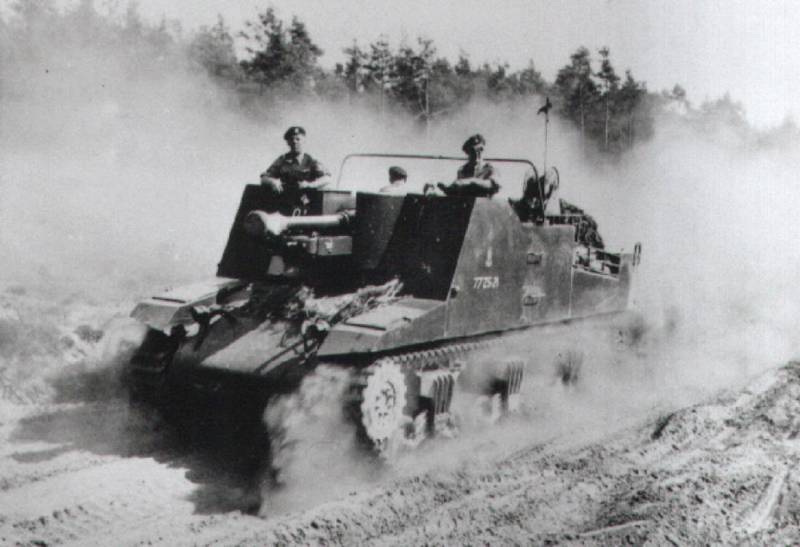
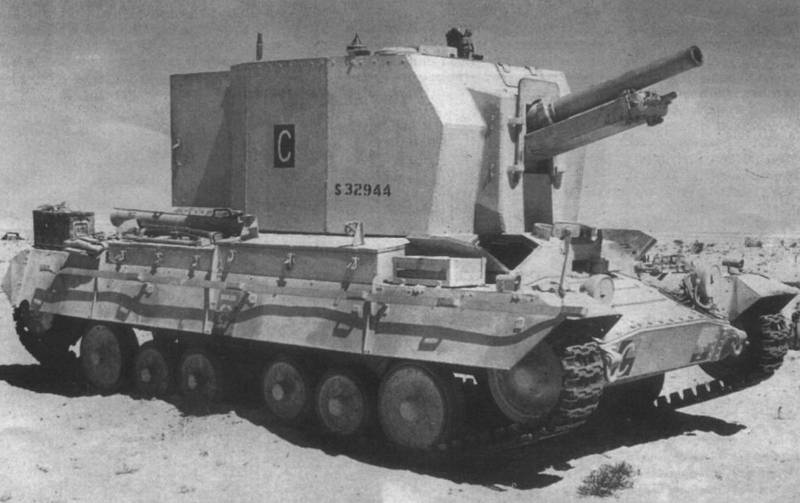


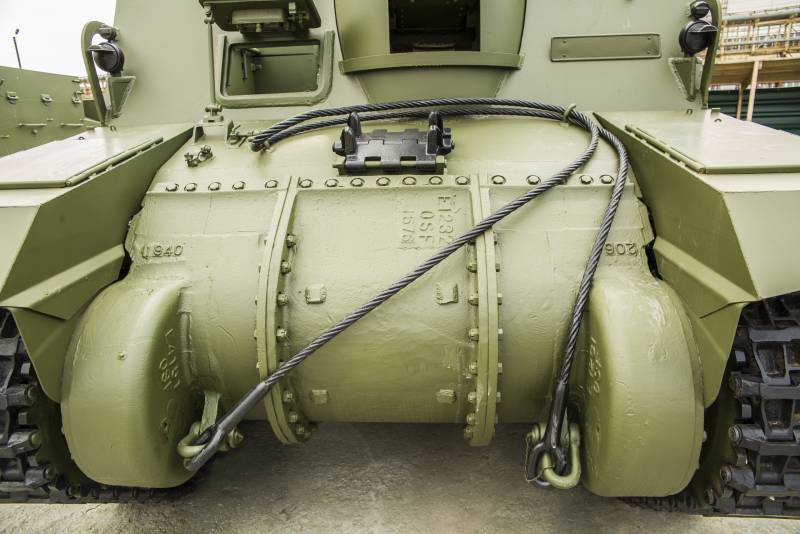
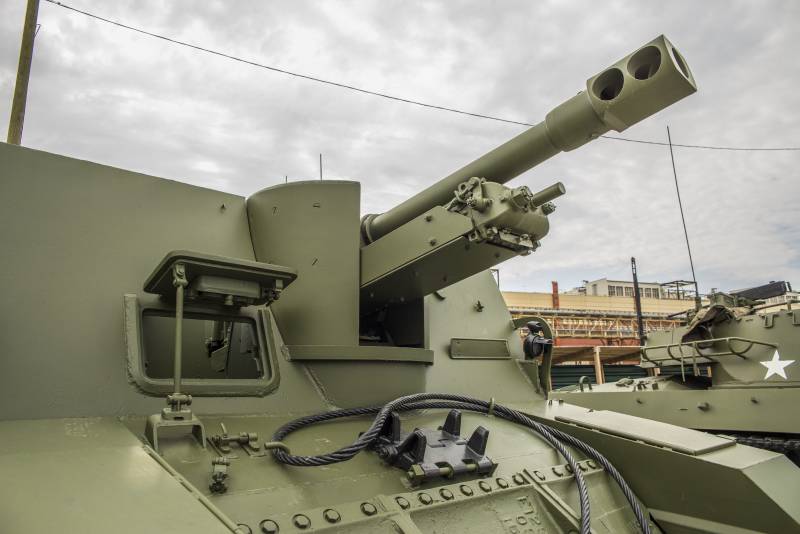



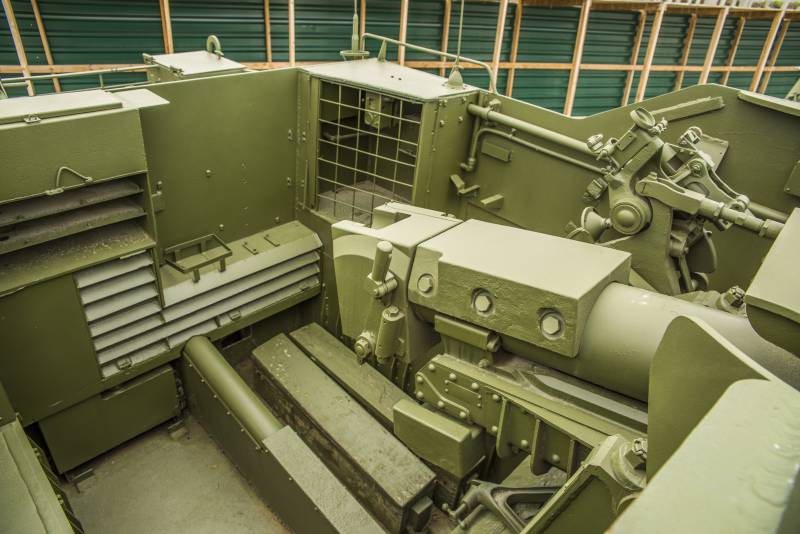










Information